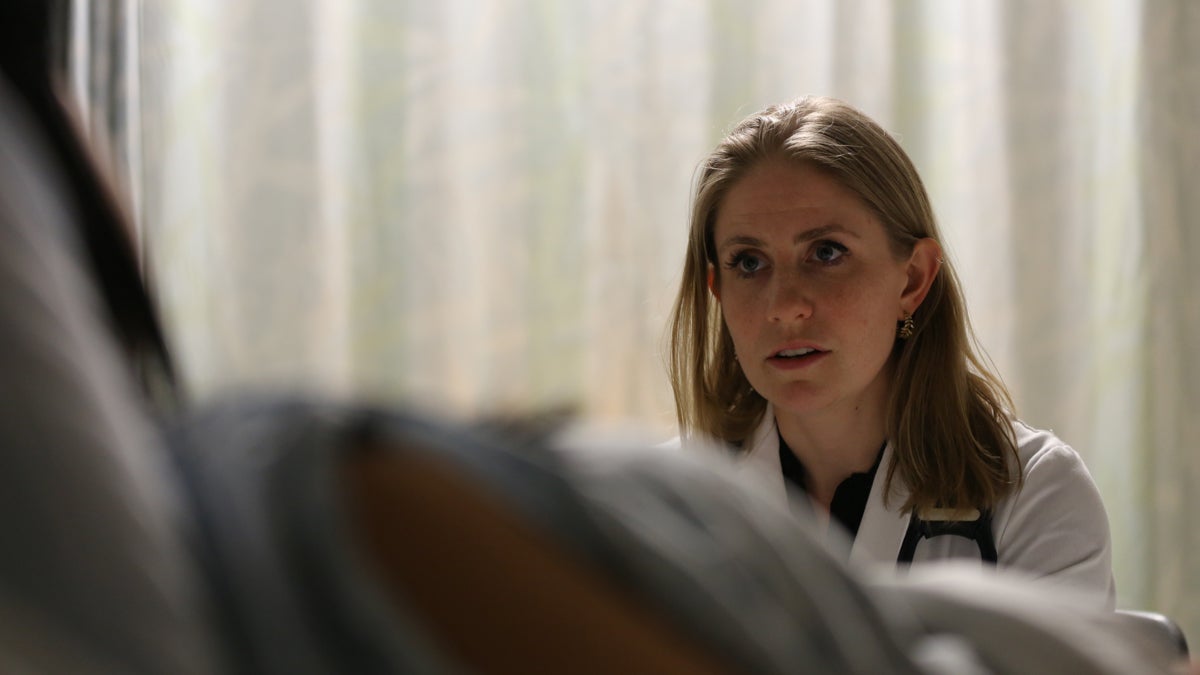Health care’s one shot at helping human trafficking victims
Listen
Dr. Hanni Stoklosa speaking to a patient. (Courtesy of Hanni Stoklosa)
Human trafficking in the United States is common, and it is often hidden in plain sight.
“This is happening all around us,” says Marketplace reporter Dan Gorenstein, who recently reported on human trafficking and health care in a three-part series.
“The Justice Department has found that 83 percent of confirmed sex-trafficked victims are in fact U.S. citizens,” he says. “I think that’s really, absolutely unknown and a real eye-opener for many Americans.”
He says that we need better data, but it is estimated that over 20 million individuals are victims of labor and sex trafficking in the U.S.
The Marketplace series features a young physician, identified only as Dr. A to protect patient safety, who had a surprising experience in the emergency department.
“I run into this weird triage note on the board,” Dr. A remembers. “It said, ‘I have a tracker in me.'”
He initially dismissed the patient’s assertion that she had a GPS chip implanted in her side, assuming she had a major psychiatric illness. But something about the patient didn’t seem to add up, and an x-ray was ordered.
“It’s there, it’s unequivocally there,” Dr. A remembers saying, as the team examined the x-ray. “No one was speaking for, it had to be at least five seconds. In an ER, in a busy ER, that’s saying something.”
The woman had a surgically implanted radio frequency identification, or RFID, chip in her flank, a device commonly used to track cats and dogs. She was tagged like an animal, it turned out, as a victim of sex trafficking.
Many human trafficking victims, however, interact with the healthcare system, yet remain unrecognized.
“Up to 88 percent of trafficking survivors do seek healthcare and are in healthcare settings at some point during their exploitation,” says Hanni Stoklosa, a physician and co-director of the advocacy organization, Heal Trafficking.
“Some of them have primary care doctors. Some of them deliver children in hospitals,” she says.
Stoklosa says changes are needed in order for the healthcare system to take advantage of the opportunity to intervene.
“The first step is awareness of the problem. In many hospitals and clinics and training programs around the country, this is not on clinicians’ radars at all… This is not a standard part of our curriculum in any way.”
In addition to raising awareness, Stoklosa argues that there need to be systematic procedures in place to identify and handle potential cases.
“Hospitals and clinics across the country [need] to have plans in place,” she says, “so that it’s not just by some random chance that someone’s screened for trafficking, that it’s not by random chance that they’re connected to resources.”
Stoklosa says that in her Emergency Department, attention to the problem has made a big difference.
“In a given week we’re identifying anywhere from one to three trafficking victims, which is a lot more. We really weren’t identifying any when we weren’t looking for them.”
Stoklosa says there are certain questions that she asks to help raise red flags.
“I ask all of my patients that I know are dealing with substance abuse, ‘How do you pay for your drugs?’ A lot of them then tell me, ‘I’m selling my body for drugs.’ And then from there, we see if there are elements of coercion.”
She asks different questions when she is suspicious of labor trafficking.
“Somebody that comes in with a weird injury that doesn’t correspond with what they’re telling me in terms of the story, one of the things I’ll ask them is, “If I give you a couple of days off from work with this work note, will you be able to take off work?’ And just seeing their reaction in response to that is really, really telling.”
But while these tactics might help, Stoklosa says it’s more about the way clinicians approach patients than the specific questions they ask.
“It’s more important to be in the moment, to be caring, to establish that trust and rapport with the patient.”
It’s also important to avoid making assumptions about patients.
“Many times these individuals have been mislabeled by something else that we’re more familiar with,” she says. “That may be domestic violence, and that’s often how the patient’s identifying it. Sexual assault… IV heroin.”
He says that when Stoklosa defines human trafficking, “there’s often a gasp, an audible gasp, because so many providers realize, “Oh my goodness, I’ve treated these people.'”
WHYY is your source for fact-based, in-depth journalism and information. As a nonprofit organization, we rely on financial support from readers like you. Please give today.



